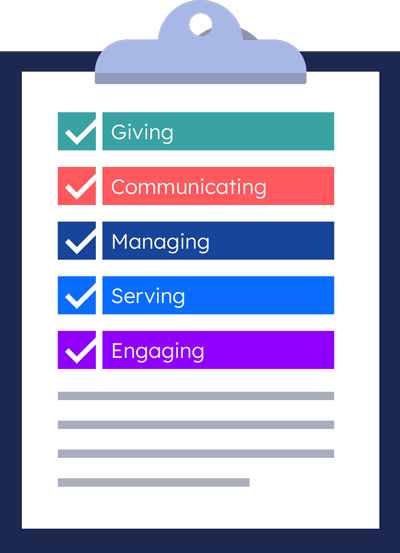How a Church Calendar Promotes Balance
The key to building a healthy balance between church life and personal responsibilities lies in intentionality. Without a structured way to view and manage church commitments, congregants are often left to react to events as they come, leading to stress and disorganization.
A congregation-facing calendar offers a proactive solution, enabling members to engage with church life in a way that enriches their faith without overwhelming their schedules.
Empowering Congregants to Plan Ahead
At the heart of any effective church calendar is the ability to empower congregants to plan ahead. When people are given a visible, up-to-date view of all upcoming events, services, and ministry opportunities, they can map out their time in advance.
This foresight allows them to integrate their church commitments alongside family responsibilities, work schedules, and personal time.
By having this clarity, congregants are no longer caught off-guard by last-minute announcements or changes. Instead, they can see the bigger picture and determine how they will participate in a way that fits comfortably into their lives.
This ability to plan in advance reduces stress and allows church members to approach their commitments with a sense of calm, rather than urgency.
Helping Prioritize Events and Reduce Guilt
Another significant benefit of congregation-facing calendars is the ability to help members prioritize events that matter most to them. Not every church gathering holds the same weight for every individual, and a well-structured calendar allows congregants to discern which activities align with their personal spiritual growth and community involvement.
When individuals have this clear view of all that’s happening, they can make thoughtful decisions about what to attend and, just as importantly, what to pass on. This eliminates the all-too-common feelings of guilt that arise when someone feels they should be attending every single event. By seeing the full scope of activities, members can say “yes” to the ones that truly resonate and “no” to others without the fear of missing out or disappointing others. This freedom to prioritize without guilt fosters a healthier, more sustainable relationship with church life.
Avoiding Over-Commitment
One of the most damaging challenges to maintaining a balanced church life is the temptation to over-commit. With frequent events and ongoing ministries, some congregants may feel pressured to attend everything, leading to a packed schedule that leaves little room for rest or personal reflection.
A congregation-facing calendar provides much-needed visibility into the overall scope of church activities, helping members see where they can be more selective with their attendance. By having a clear understanding of the church’s schedule, they can avoid unintentionally signing up for too many events in one week or overloading themselves with commitments that they may not have the capacity to fulfill.
This awareness is vital in preventing burnout. It enables members to approach their church involvement with a sense of balance and perspective, engaging in the life of the church in a way that nurtures their faith rather than depleting their energy. Through thoughtful planning and selective participation, congregants can maintain a strong connection to the church while safeguarding their personal well-being.
In this way, a congregation-facing calendar is not just a logistical tool—it is a practical means of empowering the church community to engage in a way that promotes spiritual growth without sacrificing personal health or balance.
Creating a Sustainable Church Experience for Congregants
The ultimate goal of any church should be to foster a sustainable, life-giving community where members can thrive in their faith and relationships. A congregation-facing calendar does more than organize events—it creates the framework for a balanced, long-term relationship between the church and its members. By offering clarity and accessibility, the calendar helps to shape an experience that allows for healthy participation, deeper connections, and thoughtful planning.
Encouraging Healthy Participation
Healthy participation is about more than just showing up—it’s about being engaged in a way that refreshes the soul rather than drains it. When members feel they can participate in church life without the looming threat of burnout, they are more likely to engage regularly and meaningfully. A clear, visible calendar helps achieve this by providing structure and predictability, allowing people to plan their involvement in a way that fits within the ebb and flow of their personal lives.
By promoting sustainable involvement, the church fosters an environment where members don’t feel pressured to attend everything, but are encouraged to find their own rhythm of participation. This approach nurtures a sense of freedom and joy, allowing people to contribute to the church’s mission at their own pace without feeling burdened. Over time, this leads to a healthier and more energized congregation, where participation is born out of desire rather than obligation.
Building Long-Term Relationships
Sustainable participation is the foundation upon which long-term relationships with the church are built. When members can engage without feeling overcommitted, they are more likely to remain connected over the years. These relationships deepen as congregants consistently attend services, participate in ministries, and share in community life at a pace that fits their unique circumstances.
A congregation-facing calendar plays a crucial role in facilitating these long-term connections. It helps individuals see not only the current schedule but also the broader trajectory of the church’s life, fostering a sense of continuity and belonging. As people grow in their commitment, they move beyond the surface level of attendance to become deeply rooted in the church’s mission, vision, and community. This longevity allows for the formation of meaningful relationships, not just with other members, but with the church as a whole.
Better Family & Personal Planning
For families, balancing personal schedules with church commitments can often feel like a juggling act. Between work, school, extracurricular activities, and personal responsibilities, finding the time to attend church events can be challenging. A congregation-facing calendar provides a practical solution by offering families a clear view of what’s happening in the church, allowing them to plan their personal and family schedules accordingly.
With this tool, families can make informed decisions about how to integrate church involvement into their lives without neglecting other obligations. It enables parents to make sure that their children are part of important events like Sunday School or youth group, while also managing their work schedules and household duties. The calendar becomes a bridge that helps balance family life with spiritual growth.
In this way, a congregation-facing calendar not only supports individual members but also strengthens families. It allows them to be intentional about their participation. Their church life enhances, rather than competes with, their personal and family responsibilities. Over time, this thoughtful integration creates a more sustainable, fulfilling church experience for everyone involved.










